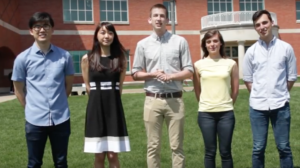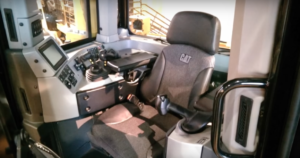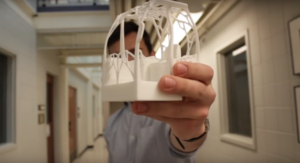As previously reported, IFPE will be home to the first-ever 3D-printed excavator, as the Association of Equipment Manufacturers (AEM), National Fluid Power Association (NFPA), Center for Compact and Efficient Fluid Power (CCEFP), Oak Ridge National Laboratory (ORNL) and the National Science Foundation (NSF) work together to showcase how 3D printing will change fluid power technology moving forward.
As part of this project, undergraduate engineering students from across the country were invited to participate in a contest to design and print a futuristic cab and a human-machine interface for the excavator that is both aesthetically pleasing and functionally designed. This contest was part of CCEFP-sponsored pre-competitive Fluid Power Research Projects. Students entered their designs for the cab of the excavator on the Center for Compact and Efficient Fluid Power website and were judged by a panel of industry experts.
The winning design was created by a team from the University of Illinois at Urbana-Champaign (UIUC) and it was comprised of five students (from left to right), Kevin Kim, Sharon Tsubaki-Liu, Luke Meyer, Naomi Audet and Andrew Peterman. They received a $2,000 cash prize and will have the opportunity to visit the Oak Ridge National Laboratory (ORNL) in Tennessee to observe the printing of the selected design.
it was comprised of five students (from left to right), Kevin Kim, Sharon Tsubaki-Liu, Luke Meyer, Naomi Audet and Andrew Peterman. They received a $2,000 cash prize and will have the opportunity to visit the Oak Ridge National Laboratory (ORNL) in Tennessee to observe the printing of the selected design.
Luke Meyer was asked a series of questions about the process and said, “Since we began at the University of Illinois, each of us has had to use 3D printing for multiple design projects. We’ve developed an understanding of not only the different types of 3D printing available (FDM, SLS, SLA, etc.) and materials used, but how to design for printing in a given situation. This experience helped to minimize support structure in the final cab design, along with general intuition for how successful the print will be. It also assisted in predicting and eliminating stress concentrations by incorporating fillets and a fluid geometry, as opposed to containing straight beams and sharp angles.”
Meyer added that when comparing to the industry standard cab, this design is one that has never before been possible.
“Current cabs will typically be constructed out of a strong material such as steel and welded together in many different steps, exhibiting high structural integrity but limiting creativity to a four-post structure. In comparison to other submissions, our team utilized Topology  Optimization (TO), which is a series of mathematical algorithms used to minimize material based on specified loading conditions within a given cab envelope,” he continued. “This process provided inspiration for creating a very organic and treelike cab structure, incorporating many curving features not possible by means of traditional manufacturing. We were also able to maximize visibility with gridded roofing and reduce both noise and vibration with structural air gaps.”
Optimization (TO), which is a series of mathematical algorithms used to minimize material based on specified loading conditions within a given cab envelope,” he continued. “This process provided inspiration for creating a very organic and treelike cab structure, incorporating many curving features not possible by means of traditional manufacturing. We were also able to maximize visibility with gridded roofing and reduce both noise and vibration with structural air gaps.”
Russel Cederberg, chief cab engineer at C< Platforms served as a judge in the competition added, “I realize that one of the goals of this project is to think outside the box and incorporate ideas that would not typically be considered in a normal design iteration. However, maybe because I’ve been working in industry to long, I found it hard to marginalize operator experience,” All teams came up with radical solutions that could positively impact manufacturability and styling. But, I thought UIUC did the best job of considering the operator, and his needs, while developing their design. I thought the UIUC team’s presentation, and report, were more polished and complete, and communication is such a large part of running a successful project.”
The excavator, including this student-led cab design, can be seen at IFPE Las Vegas Convention Center March 7-11.
For more information on IFPE 2017 visit www.mobilehydraulictips.com

